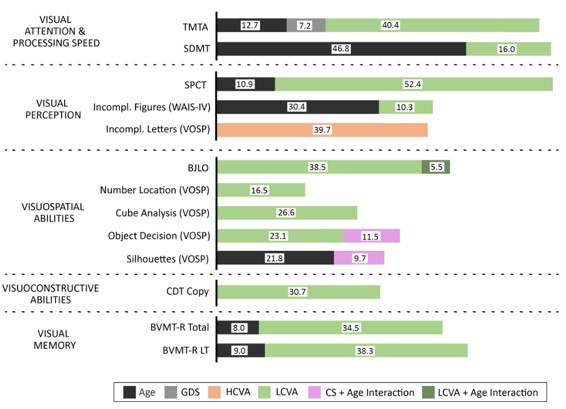Objective: We aimed to quantify the role and the association that visual disability has on the neuropsychological performance of patients with Lewy body diseases (LBD).
Background: LBD share several non-motor manifestations [1], of which early cognitive impairment and visual abnormalities are some of the most disabling ones, significantly influencing the quality of life [2,3] and being associated to the development of dementia [4,5]. However, the relation between visual and cognitive performance is not well characterized in LBD.
Method: We included 63 patients [50 idiopathic Parkinson’s disease, 8 dementia with Lewy bodies and 5 E46K-SNCA mutation carriers] and 22 healthy controls. All participants underwent visual function tests performed binocularly with best-corrected refraction [high and low contrast visual acuity (HCVA and LCVA) and contrast sensitivity (CS)] and a comprehensive battery of visual cognition. Age-corrected partial correlations and stepwise linear regressions were performed to estimate the relation between primary visual function and visual cognition tests.
Results: LCVA was the visual variable that best correlated with cognitive tests and that best predicted visual cognition in patients (and not in controls), explaining up to 52.4% of variance for visual perception, 40.4% for visual attention, 38.5% for visuospatial abilities, 38.3% for visual memory, and 30.7% of visuoconstructive abilities. HCVA explained 39.7% and the interaction between CS and age 11.5% of the variance of visual perception and visuospatial abilities, respectively.
Conclusion: LCVA has a significant impact on visual cognition in LBD patients, being a relevant factor for the neuropsychological performance and might be a sensitive marker of cognitive impairment.
References: 1. Schapira AHV, Chaudhuri KR, Jenner P. Non-motor features of Parkinson disease. Nat Rev Neurosci 2017;18(7):435-50. doi: 10.1038/nrn.2017.62 [published Online First: 2017/06/09] 2. Almer Z, Klein KS, Marsh L, et al. Ocular motor and sensory function in Parkinson’s disease. Ophthalmology 2012;119(1):178-82. doi: 10.1016/j.ophtha.2011.06.040 [published Online First: 2011/10/01] 3. Barone P, Erro R, Picillo M. Quality of Life and Nonmotor Symptoms in Parkinson’s Disease. Int Rev Neurobiol 2017;133:499-516. doi: 10.1016/bs.irn.2017.05.023 [published Online First: 2017/08/15] 4. Pigott K, Rick J, Xie SX, et al. Longitudinal study of normal cognition in Parkinson disease. Neurology 2015;85(15):1276-82. doi: 10.1212/WNL.0000000000002001 [published Online First: 2015/09/13] 5. Weil RS, Schrag AE, Warren JD, et al. Visual dysfunction in Parkinson’s disease. Brain 2016;139(11):2827-43. doi: 10.1093/brain/aww175 [published Online First: 2016/07/15]
To cite this abstract in AMA style:
R. Del Pino, M. Acera, A. Murueta-Goyena, O. Lucas-Jiménez, N. Ojeda, N. Ibarretxe-Bilbao, J. Peña, P. Reyero, J. Cortés, B. Tijero, M. Galdós, J.C Gómez-Esteban, I. Gabilondo. The role of low contrast visual acuity in cognitive performance in Lewy body diseases [abstract]. Mov Disord. 2020; 35 (suppl 1). https://www.mdsabstracts.org/abstract/the-role-of-low-contrast-visual-acuity-in-cognitive-performance-in-lewy-body-diseases/. Accessed December 2, 2025.« Back to MDS Virtual Congress 2020
MDS Abstracts - https://www.mdsabstracts.org/abstract/the-role-of-low-contrast-visual-acuity-in-cognitive-performance-in-lewy-body-diseases/

